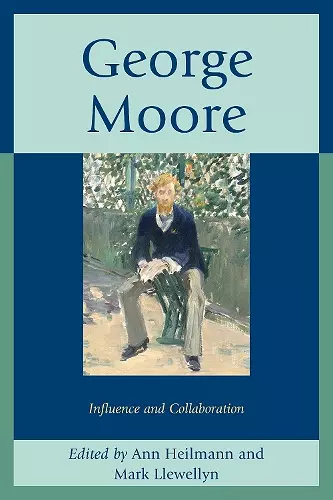George Moore
Influence and Collaboration
Ann Heilmann editor Mark Llewellyn editor
Format:Hardback
Publisher:Rowman & Littlefield
Published:6th Aug '14
Currently unavailable, and unfortunately no date known when it will be back

“Nearly every major figure of his era,” writes his biographer Adrian Frazier, “worked with Moore, tangled with Moore, took his impression from, or left it on, George Moore.” The Anglo-Irish novelist George Moore (1852–1933) espoused multiple identities. An agent provocateur whether as an art critic, novelist, short fiction writer or memoirist, always probing and provocative, often deliberately controversial, the personality at the core of this book invented himself as he reinvented his contemporary world. Moore’s key role—as observer-participant and as satirist—within many literary and aesthetic movements at the end of the Victorian period and into the twentieth century owed considerably to the structures and manners of collaboration that he embraced. This book throws into relief the multiple ways in which Moore’s work can serve as a counterbalance to established understandings of late nineteenth and early twentieth-century literary aesthetics both through innovative scholarly readings of Moore’s work and through illustrative case studies of Moore’s collaborative practice by making available, for the first time, two manuscript plays he co-authored with Pearl Craigie (John Oliver Hobbes) in 1894. It is this collaborative practice in conjunction with his cosmopolitan outlook that turned Moore into a key player in the fin-de-siècle formation of an international aesthetic community. This book explores the full range of Moore’s collaborations and cultural encounters: from 1870s Paris art exhibitions to turn-of-the-century Dublin and London; from gossip to the culture of the barmaid; from the worship of Balzac to the fraught engagement with Yeats; from music to Celtic cultural translation. Moore’s reputation as a collaborator with the most significant artistic individuals of his time in Britain, Ireland and France in particular, but also in Europe more widely, provides a rich exposition of modes of exchange and influence in the period, and a unique and distinctive perspective on Moore himself.
The work of George Moore (1852-1933) has received revived attention in recent years, and there have been many reconsiderations of the importance of Moore’s diverse body of work. Heilmann and Llewellyn have previously played a part in this revival, having coedited The Collected Short Stories of George Moore (5v, 2007). The essays in the present volume reconsider Moore's collaborations with and impact on his literary and artistic contemporaries. Part 1, 'Influence,' offers new readings of his various interactions with writers and artists in France, Ireland, and Wales and England, locating Moore at the center of important cultural encounters and debates. Essays explore his art criticism, his literary self-fashioning, his interest in music, and his understanding of gossip as a form of art. Three chapters consider his various depictions of women and their relationship to similar figures in new woman fiction. In part 2, 'Collaboration,' the editors examine Moore's partnerships with other authors, especially Pearl Craigie, and provide annotated transcripts of two coauthored plays. This collection will help to raise awareness of Moore’s largely unrecognized contributions to the cultural movements of the fin de siècle. Summing Up: Recommended. Upper-division undergraduates and above. * CHOICE *
[T]he essays in this latest collection navigate . . . [Moore's] contradictory character . . . singularly well. . . .[I]t is certainly work such as this that will turn the recent enthusiasm for "Moore studies" into a more long-term change of heart towards Moore, allowing genuinely new and exciting insights into his creative processes. * The Cambridge Quarterly *
George Moore was a central figure in turn-of-the-century British literature because he was involved in and influenced so many different movements. Ironically, this is why he remains difficult for many to assess. George Moore: Influence and Collaboration brings together experts on Moore that offer a range of discussions that coherently addresses his varied influence on writers and artists of the era. This is a very fine collection of essays of keen interest not only to readers of Moore but also those interested in the Transition age at large. -- Professor Robert Langenfeld, Editor, English Literature in Transition, 1880–1920
ISBN: 9781611494327
Dimensions: 237mm x 160mm x 25mm
Weight: 581g
310 pages